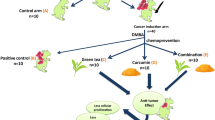Abstract
In separate experimental models the effects of selenium, zinc, potassium, and copper on angiogenesis and carcinogenesis are compared. Inhibitory effects of Se as Na2SeO3 and of chloride salts of K and Zn, but not of Cu, on vascularization induced by amelanotic tumor implants (A Mel-4B32) in the Syrian hamster cheek pouch membrane are reported. In an earlier study the induction of new vasculature, angiogenesis, in control chambers implanted with A Mel-4B32 was initially observed on day 4 after implant. Addition of 5, 10, and 50 μg Se at the time of tumor implant delayed the initial capillary proliferation to days 7, 9, 10, respectively (Cancer Lett. 9, 353, 1980). Similarly, in this report addition of 50 μg Zn or 50 μg K delayed angiogenesis to days 7.and 6, respectively. By contrast, addition of 50 μg Cu caused severe inflammation and necrosis of the membrane before capillary proliferation could be observed and the animals had to be sacrificed.
In an earlier study we reported the colon tumor incidence in 1,2-dimethylhydrazine (20 mg DMG/kg body weight for 20 weeks) -treated Sprague Dawley rats was reduced from 87 to 40% by a 4 ppm Se (as Na2SeO3) supplement in the drinking water (Cancer Lett. 2, 133, 1977). In this study rats were treated with the same dose of carcinogen, but were sacrificed 14 weeks following the last DMH injection. Drinking water supplements with 0.02% Zn (as ZnCl2), 0.5% K (as KCl), or 0.01% Cu (as CuCl2) were provided concurrently with the carcinogen and were continued until death or sacrifice. The colon tumor incidence was 18/20 in the DMH control and was reduced to 16/20 by supplemental Zn, reduced to 12/20 by supplemental K, and was unchanged (18/20) by Cu. The tumor incidences in the small intestine and Zymbal gland were all reduced by Zn, K, and Cu supplements compared with the DMH control. The hamster cheek pouch technique may provide a prescreen for potential inhibitors of chemical carcinogenesis in other experimental models.
Similar content being viewed by others
References
C. M. Goodall, A. G. Sanders, and P. Shubik,J. Natl. Cancerlnst. 35, 497 (1965).
M. Greenblatt and P. Shubik,J. Natl. Cancer Inst. 41, 111 (1968).
J. Folkman, E. Merler, and C. Abernathy,J. Exp. Med. 133, 275 (1971).
R. Langer, H. Conn J.Vacanti, C. Haudenschild, and J. Folkman,Proc. Natl. Acad. Sci. USA. 77, 4331 (1980).
S. Taylor and J. Fotkman,Nature 297, 307 (1982).
M. M. Jacobs, P. Shubik, and R. Feldman,Cancer Lett. 9, 353 (1980).
L. F. Chasseaud,Adv. Cancer Res. 29, 175 (1979).
P. R. Harbach and J. A. Swenberg,Carcinogenesis 2, 575 (1981).
L. W. Wattenberg,Adv. Cancer Res. 26, 197 (1978).
M. Greenblatt, K. V. Choudari, A. G. Sanders, and P. Shubik,Microvasc. Res. 1, 420 (1969).
M. M. Jacobs and A. C. Griffin, eds.,Inhibition of Tumor Induction and Development, Plenum, New York, 1981, pp. 169–188.
A. Tannebaum and H. Silverstone, eds.,Cancer, Butterworth, London, 1957, pp. 306–334.
J. R. Duncan and I. E. Dreosti,J. Natl. Cancer lnst. 55, 195 (1975).
D. W. Poswillo and R. Cohen,Nature 231, 447 (1971).
G. Fare,Biochem. J. 91, 473 (1964).
G. Fare and J. S. Howell,Cancer Res. 24, 1279 (1964).
Y. Yamane and K. Sakai,Chem. Pharm. Bull. (Tokyo) 22, 1125 (1974).
Y. Yamane, K. Sakai, I. Uchiyama, M. Tabata, N. Taga, and A. Hanaki,Chem. Pharm. Bull. (Tokyo) 17, 2488 (1969).
M. Kanisawa and H. A. Schroeder,Cancer Res. 27, 1192 (1967).
M. Kanisawa and H. A. Schroeder,Cancer Res. 29, 892 (1969).
J. Durlach, P. Larvor, Y. Augusti, and E. Albengres-Moineau,Concours Med. 95, 6296 (1973).
G. P. O’Hara, D. E. Mann, and R. F. Gautieri,J. Pharm. Sci. 60, 473 (1971).
N. Kobayashi, H. Katsuki, and Y. Yamane,Gann 61, 239 (1970).
T. Gorski,Neoplasia 15, 267 (1968).
S.A. Gunn, T. C. Gould, and W. A. Anderson,J. Natl. Cancerlnst. 31, 745 (1963).
S.A. Gunn, T. C. Gould, and W. A. Anderson,Proc. Soc. Exp. Biol. Med. 115, 653 (1963).
F. W. Sunderman, T. J. Lau, and L. J. Cralley,Cancer Res. 34, 92 (1974).
M. M. Jacobs, B. Jansson, and A. C. Griffin,Cancer Lett. 2, 133 (1977).
P. M. Gullino,J. Natl. Cancer. Inst. 61, 639 (1978).
Author information
Authors and Affiliations
Rights and permissions
About this article
Cite this article
Jacobs, M.M. Trace element inhibition of carcinogenesis and angiogenesis. Biol Trace Elem Res 5, 375–381 (1983). https://doi.org/10.1007/BF02987221
Received:
Accepted:
Issue Date:
DOI: https://doi.org/10.1007/BF02987221
Index Entries
- Selenium, in carcinogenesis and angiogenesis
- potassium, in carcinogenesis and angiogenesis
- zinc, in carcinogenesis and angiogenesis
- angiogenesis, trace element inhibition of
- inhibition of carcinogenesis and angiogenesis by trace elements
- carcinogenesis, inhibition by trace elements
- colon cancer
- transparent chamber
- 1,2-dimethylhydrazine
- hamster cheek pouch
- copper, in angiogenesis and carcinogenesis




